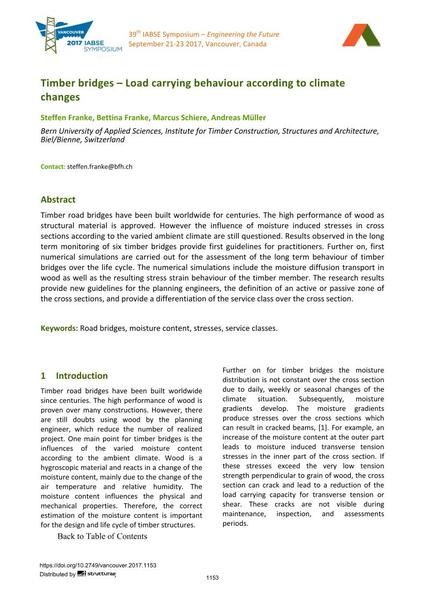Timber bridges – Load carrying behaviour according to climate changes

|
|
|||||||||||
Détails bibliographiques
| Auteur(s): |
Steffen Franke
(Bern University of Applied Sciences, Institute for Timber Construction, Structures and Architecture, Biel/Bienne, Switzerland)
Bettina Franke (Bern University of Applied Sciences, Institute for Timber Construction, Structures and Architecture, Biel/Bienne, Switzerland) Marcus Schiere (Bern University of Applied Sciences, Institute for Timber Construction, Structures and Architecture, Biel/Bienne, Switzerland) Andreas Müller (Bern University of Applied Sciences, Institute for Timber Construction, Structures and Architecture, Biel/Bienne, Switzerland) |
||||
|---|---|---|---|---|---|
| Médium: | papier de conférence | ||||
| Langue(s): | anglais | ||||
| Conférence: | IABSE Symposium: Engineering the Future, Vancouver, Canada, 21-23 September 2017 | ||||
| Publié dans: | IABSE Symposium Vancouver 2017 | ||||
|
|||||
| Page(s): | 1153-1160 | ||||
| Nombre total de pages (du PDF): | 8 | ||||
| Année: | 2017 | ||||
| DOI: | 10.2749/vancouver.2017.1153 | ||||
| Abstrait: |
Timber road bridges have been built worldwide for centuries. The high performance of wood as structural material is approved. However the influence of moisture induced stresses in cross sections according to the varied ambient climate are still questioned. Results observed in the long term monitoring of six timber bridges provide first guidelines for practitioners. Further on, first numerical simulations are carried out for the assessment of the long term behaviour of timber bridges over the life cycle. The numerical simulations include the moisture diffusion transport in wood as well as the resulting stress strain behaviour of the timber member. The research results provide new guidelines for the planning engineers, the definition of an active or passive zone of the cross sections, and provide a differentiation of the service class over the cross section. |
||||
| Mots-clé: |
ponts-routes
|
||||
